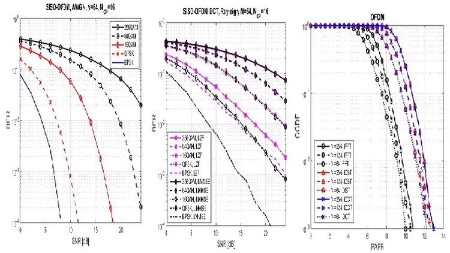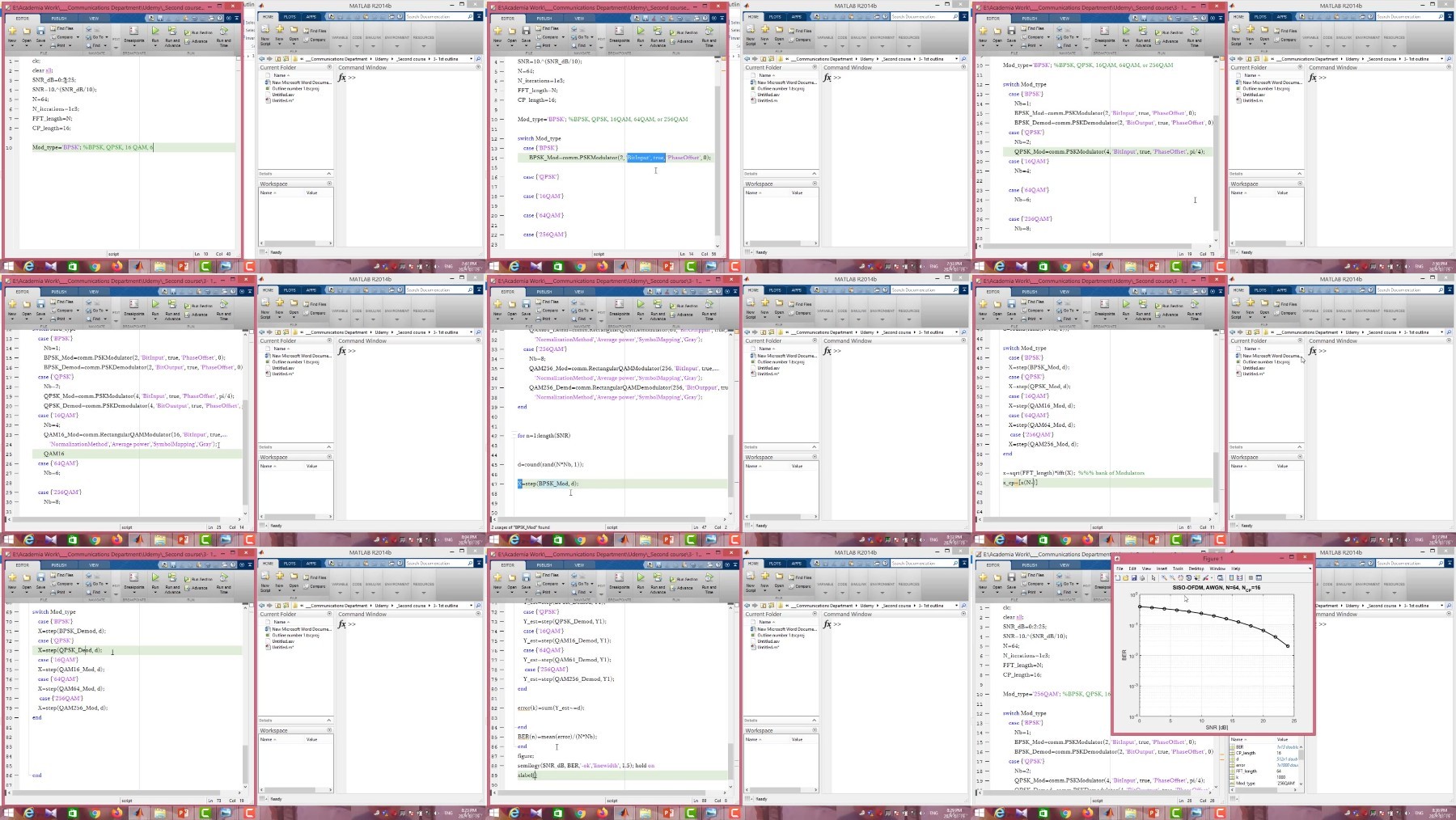Most Commented
The Complete Matlab Course for Wireless Comm. Engineering




Description material

The Complete Matlab Course for Wireless Comm. Engineering
Duration: 5h 0m | .MP4 1280x720, 30 fps(r) | AAC, 44100 Hz, 2ch | 2.6 GB
Genre: eLearning | Language: English
A step by step the Matlab codes for BER/CFO/PAPR estimations of different Comm. systems like OFDM and NOMA Comm. systems
What you'll learn:
How to estimate the Bit-Error-Rate (BER) performance over a Single-Input-Single-Output Orthogonal Frequency Division Multiplexing (SISO-OFDM) communication system based on Fast Fourier Transform (FFT) over an Additive White Gaussian Noise (AWGN) channel using different mapping schemes?
How to generate a Rayleigh fading channel based on the Jakes fading model?
How to estimate the BER performance over a SISO-OFDM communication system based on FFT over a Rayleigh fading channel without equalization procedure?
How to estimate the BER performance over a SISO-OFDM communication system based on FFT over a Rayleigh fading channel with equalization procedure?
Study the Effect of the Carrier Frequency Offset (CFO) problem.
How to estimate the Mean Square Error (MSE) performance for CFO estimation of OFDM communication system based on FFT Using Cyclic Prefix (CP) symmetry property over an AWGN channel and Rayleigh fading channel?
How to estimate the BER performance over a SISO-OFDM communication system based on Discrete Sine Transform (DST) over an AWGN channel using different mapping schemes?
How to estimate the BER performance over a SISO-OFDM communication system based on DST over a Rayleigh fading channel using different equalizers?
How to estimate the BER performance over a SISO-OFDM communication system based on Discrete Cosine Transform (DCT) over an AWGN channel using different mapping schemes?
How to estimate the BER performance over a SISO-OFDM communication system based on DCT over a Rayleigh fading channel using different equalizers?
A comparison between the BER performance of different SISO-OFDM communication systems based on FFT, DST, and DCT over a Rayleigh fading channel.
How to estimate the Peak-to-Average Power Ratio (PAPR) for OFDM communication system based on FFT?
How to estimate the PAPR for OFDM communication system based on DST?
How to estimate the PAPR for OFDM communication system based on DCT?
A comparison between the PAPR of different OFDM communication systems based on FFT, DST, and DCT will be presented.
The concept of a NtxNr configuration, where Nt, is the number of transmitting antennas, and Nr is the number of receiving antennas will be presented.
A general code for BER estimation in case of a NtxNr configuration for OFDM communication system based on FFT over a Rayleigh fading channel will be presented.
A general code for BER estimation in case of a NtxNr configuration for OFDM communication system based on DST over a Rayleigh fading channel will be presented.
A general code for BER estimation in case of a NtxNr configuration for OFDM communication system based on DCT over a Rayleigh fading channel will be presented.
The concepts of the Power Domain Multiplexing (PDM), and Successive Interference Cancellation (SIC) of the Non-Orthogonal Multiple Access (NOMA), which used in the 5G communication systems will be presented.
The differences between the interleaved and localized sub-carrier mapping.
How to estimate the BER performance for a FFT pre-coded downlink NOMA based on FFT-OFDM communication system using localized/interleaved sub-carrier mapping over a Rayleigh fading channel?
How to estimate the BER performance for a DST pre-coded downlink NOMA based on FFT-OFDM communication system using localized/interleaved sub-carrier mapping over a Rayleigh fading channel?
How to estimate the BER performance for a DCT pre-coded downlink NOMA based on FFT-OFDM communication system using localized/interleaved sub-carrier mapping over a Rayleigh fading channel?
How to estimate the BER performance for a DST pre-coded downlink NOMA based on DST-OFDM communication system using localized/interleaved sub-carrier mapping over a Rayleigh fading channel?
How to estimate the BER performance for a DCT pre-coded downlink NOMA based on DCT-OFDM communication system using localized/interleaved sub-carrier mapping over a Rayleigh fading channel?
How to estimate the PAPR for a FFT pre-coded NOMA based on FFT-OFDM communication system using localized sub-carrier mapping?
How to estimate the PAPR for a DST pre-coded NOMA based on FFT-OFDM communication system using localized/interleaved sub-carrier mapping?
How to estimate the PAPR for a DCT pre-coded NOMA based on FFT-OFDM communication system using localized/interleaved sub-carrier mapping?
How to estimate the PAPR for a DST pre-coded NOMA based on DST-OFDM communication system using localized/interleaved sub-carrier mapping?
How to estimate the PAPR for a DCT pre-coded NOMA based on DCT-OFDM communication system using localized sub-carrier mapping?
Requirements:
Matlab Program
Description:
This is course is designed for under and postgraduate students associated to the electronics and communication engineering department. It has 31 introductions , each introduction discusses the theoretical explanation and the simulated figures that obtained through the explanation of the course. This course saves many months of hard work.
Using the Matlab program, you will learn:
1-How to estimate the Bit-Error-Rate (BER) performance over a Single-Input-Single-Output Orthogonal Frequency Division Multiplexing (SISO-OFDM) communication system based on Fast Fourier Transform (FFT) over an Additive White Gaussian Noise (AWGN) channel using different mapping schemes?
2-How to generate a Rayleigh fading channel based on the Jakes fading model?
3-How to estimate the BER performance over a SISO-OFDM communication system based on FFT over a Rayleigh fading channel without equalization procedure?
4-How to estimate the BER performance over a SISO-OFDM communication system based on FFT over a Rayleigh fading channel with equalization procedure?
5-Study the Effect of the Carrier Frequency Offset (CFO) problem.
6-How to estimate the Mean Square Error (MSE) performance for CFO estimation of OFDM communication system based on FFT Using Cyclic Prefix (CP) symmetry property over an AWGN channel and Rayleigh fading channel?
7-How to estimate the BER performance over a SISO-OFDM communication system based on Discrete Sine Transform (DST) over an AWGN channel using different mapping schemes?
8-How to estimate the BER performance over a SISO-OFDM communication system based on DST over a Rayleigh fading channel using different equalizers?
9-How to estimate the BER performance over a SISO-OFDM communication system based on Discrete Cosine Transform (DCT) over an AWGN channel using different mapping schemes?
10-How to estimate the BER performance over a SISO-OFDM communication system based on DCT over a Rayleigh fading channel using different equalizers?
11-How to estimate the Peak-to-Average Power Ratio (PAPR) for OFDM communication system based on FFT?
12-How to estimate the PAPR for OFDM communication system based on DST?
13-How to estimate the PAPR for OFDM communication system based on DCT?
14-Proposal of a general code for BER estimation in case of a NtxNr configuration for OFDM communication system based on FFT/DST/DCT over a Rayleigh fading channel will be presented.
15-How to estimate the BER performance for a FFT/DST/DCT pre-coded downlink NOMA based on FFT-OFDM communication system using localized/interleaved sub-carrier mapping over a Rayleigh fading channel?
16-How to estimate the BER performance for a DST/DCT pre-coded downlink NOMA based on DST/DCT-OFDM communication system, respectively using localized/interleaved sub-carrier mapping over a Rayleigh fading channel?
17-How to estimate the PAPR for a FFT/DST/DCT pre-coded NOMA based on FFT-OFDM communication system using localized/interleaved sub-carrier mapping?
18-How to estimate the PAPR for a DST/DCT pre-coded NOMA based on DST/DCT-OFDM communication system, respectively using localized/interleaved sub-carrier mapping?
Who this course is for:
This is course is designed for under and postgraduate students associated with the electronics and communication engineering department
More Info

Warning! You are not allowed to view this text.
Warning! You are not allowed to view this text.
Warning! You are not allowed to view this text.
Join to our telegram Group
Information
Users of Guests are not allowed to comment this publication.
Users of Guests are not allowed to comment this publication.
Choose Site Language
Recommended news
Commented



![eM Client Pro 9.2.1735 Multilingual [Updated]](https://pikky.net/medium/wXgc.png)






![Movavi Video Editor 24.0.2.0 Multilingual [ Updated]](https://pikky.net/medium/qhrc.png)

